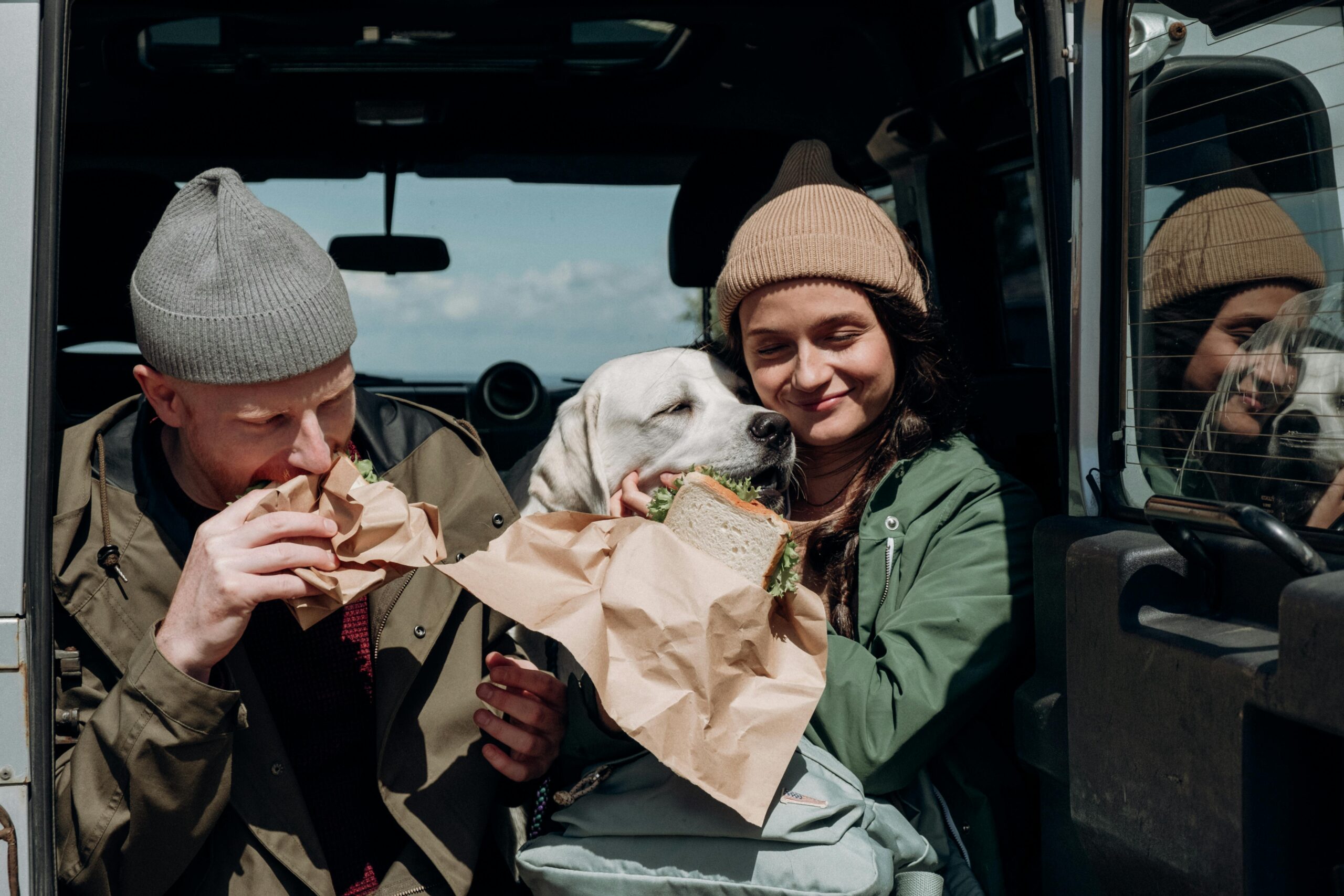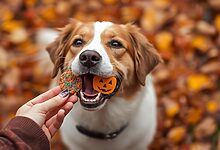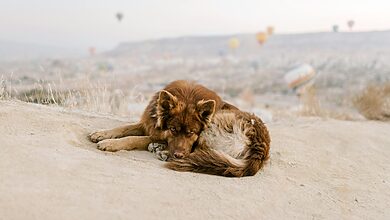The Complete Pet Travel Diet Guide 2025: Safe Feeding Strategies for Happy, Healthy Traveling Pets

According to the 2024 American Pet Products Association survey, over 78% of pet parents now travel with their furry companions regularly. However, maintaining proper nutrition while traveling remains the top concern for 89% of pet owners.
Your pet’s travel diet directly impacts their comfort, health, and happiness during your adventures together. More importantly, improper feeding while traveling can lead to digestive upset, dehydration, and serious health complications.
This comprehensive guide provides veterinary-approved, safety-first strategies for feeding your beloved companion during travel. Every recommendation prioritizes your pet’s well-being while ensuring stress-free journeys for both of you.
Table of contents
- Essential Pet Travel Diet Safety Guidelines & Expert Insights
- Complete Pet Travel Diet Solutions Guide
- Pre-Travel Diet Preparation – Professional Analysis
- Travel Day Feeding Strategy – Professional Analysis
- Destination Feeding Protocols – Professional Analysis
- Emergency Feeding Contingencies – Professional Analysis
- Hydration Management Systems – Professional Analysis
- Multi-Pet Travel Feeding – Professional Analysis
- Special Diet Maintenance – Professional Analysis
- Your Pet Travel Diet Success Timeline
- Breed-Specific Pet Travel Diet Adaptations
- Essential Pet Travel Diet Professional Toolkit
- Common Pet Travel Diet Challenges & Solutions
- Expert Pet Parent FAQ – Pet Travel Diet
- Pet Travel Diet Seasonal & Life-Stage Considerations
- Celebrating Your Pet Travel Diet Journey Success
Essential Pet Travel Diet Safety Guidelines & Expert Insights
Veterinary-Approved Safety Protocols
Travel feeding requires careful consideration of your pet’s individual needs and potential health risks. Veterinarians consistently emphasize three critical safety points for pet travel nutrition.
First, never introduce new foods during travel. Your pet’s digestive system handles stress differently, making them more susceptible to food sensitivities and upset stomachs.
Second, maintain consistent feeding schedules whenever possible. Disrupted meal times can cause anxiety and digestive issues in sensitive pets.
Third, always pack emergency contact information for veterinarians along your travel route. Knowing where to seek help prevents minor issues from becoming major health crises.
Expert Credentials & Methodology
This guide incorporates recommendations from the American Veterinary Medical Association and certified animal nutritionists. Our methodology combines peer-reviewed research with practical field experience from professional pet travel consultants.
Additionally, we’ve consulted with emergency veterinarians who regularly treat travel-related digestive issues. Their insights help identify common feeding mistakes that pet parents unknowingly make while traveling.
Furthermore, input from certified dog trainers and animal behaviorists ensures our recommendations support both physical health and emotional well-being during travel.
Breed & Individual Considerations
Small breed dogs have faster metabolisms and may require more frequent feeding during long travel days. Their tiny stomachs also make them more susceptible to hypoglycemia if meals are delayed.
Large breeds, conversely, benefit from smaller, more frequent meals during travel to prevent dangerous gastric torsion. Giant breeds require special consideration for joint health and mobility during rest stops.
Senior pets often have specific dietary requirements and medications that must be maintained precisely during travel. Age-related health conditions make consistent nutrition even more critical.
Cats typically handle travel stress differently than dogs, often refusing food entirely during initial travel periods. Understanding feline feeding psychology prevents forced feeding and related complications.
Complete Pet Travel Diet Solutions Guide
Pre-Travel Diet Preparation – Professional Analysis
Method Overview & Benefits
Preparation begins 2-3 weeks before departure with gradual dietary adjustments and health assessments. This approach minimizes travel-day stress while ensuring optimal digestive health.
Benefits include reduced anxiety, improved appetite during travel, and decreased risk of digestive upset. Proper preparation also helps identify potential food sensitivities before you’re away from your regular veterinarian.
Step-by-Step Implementation
Start by scheduling a pre-travel veterinary checkup to address any existing digestive sensitivities. Discuss your travel plans and get specific feeding recommendations for your pet’s individual needs.
Next, gradually introduce any travel-specific foods or treats you plan to use. This process should take 7-10 days, mixing new items with familiar foods to prevent upset.
Create a detailed feeding schedule that accounts for time zone changes and travel logistics. Practice this schedule at home to help your pet adjust before departure.
Finally, compile emergency veterinary contacts for your destination and route. Research pet-friendly restaurants and stores along your path for backup food sources.
Safety Considerations & Red Flags
Never change your pet’s diet dramatically within two weeks of travel. Sudden dietary changes can cause severe digestive upset, especially when combined with travel stress.
Watch for signs of food anxiety or appetite changes during preparation. Some pets become stressed just from routine changes, requiring additional preparation time.
Avoid introducing any supplements or medications without veterinary approval. Even natural products can interact with travel stress in unexpected ways.
Cost Analysis & Value Assessment
Pre-travel preparation costs $150-300 including veterinary consultation and trial foods. This investment prevents expensive emergency veterinary visits and ensures comfortable travel for everyone involved.
Travel Day Feeding Strategy – Professional Analysis
Method Overview & Benefits
Travel day feeding requires careful timing to prevent motion sickness while maintaining energy levels. The goal is keeping your pet comfortable without overeating before movement.
This strategy reduces vomiting, maintains blood sugar stability, and supports calm behavior during travel. Proper timing also prevents bathroom emergencies during inconvenient moments.
Step-by-Step Implementation
Feed your pet a light meal 3-4 hours before departure, offering about 75% of their normal portion. This timing allows digestion while preventing empty stomach nausea.
Provide small water portions frequently rather than large amounts at once. Frozen water bottles can serve double duty as cooling devices and slow-release hydration sources.
Pack easily digestible treats for reward-based calm behavior during travel. Avoid high-fat treats that could cause stomach upset in stressful situations.
Monitor your pet’s comfort level and adjust feeding frequency based on their individual response to travel conditions.
Safety Considerations & Red Flags
Never feed your pet immediately before or during active travel. Motion sickness becomes significantly more dangerous when combined with full stomachs.
Watch for excessive drooling, restlessness, or panting that might indicate nausea. These signs require immediate attention and possible feeding schedule adjustment.
Avoid giving unfamiliar treats or foods as comfort measures. Stress can make pets more sensitive to foods they normally tolerate well.
Cost Analysis & Value Assessment
Travel day supplies cost $25-50 and prevent costly cleanup and potential health issues. The minimal investment ensures comfortable travel conditions for both pets and owners.
Destination Feeding Protocols – Professional Analysis
Method Overview & Benefits
Establishing feeding routines at your destination helps pets adjust quickly while maintaining digestive health. Consistency becomes even more critical in unfamiliar environments.
Benefits include faster adjustment periods, reduced anxiety, and maintained appetite in new surroundings. Proper protocols also prevent overeating from stress or unfamiliar schedules.
Step-by-Step Implementation
Set up feeding stations in quiet areas away from high-traffic zones. Familiar food bowls and placement help create comfort in new environments.
Maintain home feeding schedules as closely as possible, adjusting gradually for time zone differences. Sudden schedule changes can disrupt digestion and bathroom routines.
Introduce local water gradually by mixing with familiar water from home. Some pets are sensitive to mineral content differences in regional water supplies.
Keep detailed logs of eating habits and bathroom schedules to identify any adjustment issues early.
Safety Considerations & Red Flags
Never allow pets to eat from unfamiliar sources or investigate local wildlife food sources. Regional toxins and parasites pose serious health risks to traveling pets.
Monitor for signs of water sensitivity including excessive thirst, lethargy, or digestive changes. Some regions have mineral content that affects sensitive pets.
Avoid feeding in areas where local wildlife might compete for food. This prevents dangerous encounters and food guarding behaviors.
Cost Analysis & Value Assessment
Destination setup costs $40-75 for familiar supplies and water testing if needed. This investment ensures smooth adjustment and prevents stress-related health issues.
Emergency Feeding Contingencies – Professional Analysis
Method Overview & Benefits
Emergency feeding plans prepare pet parents for unexpected situations including delayed travel, food shortages, or digestive emergencies. Preparation prevents panic decisions that could worsen situations.
Having contingency plans reduces stress for both pets and owners while ensuring appropriate nutrition continues despite complications.
Step-by-Step Implementation
Research emergency veterinary services and 24-hour pet stores along your entire route. Keep this information easily accessible in multiple formats.
Pack 3-5 days of extra food beyond your planned trip duration. Unexpected delays or lost luggage shouldn’t compromise your pet’s nutrition.
Carry basic first aid supplies including bland diet ingredients like plain rice and boiled chicken for digestive upset management.
Establish communication protocols with your home veterinarian for remote consultation if needed during emergencies.
Safety Considerations & Red Flags
Never attempt to treat serious digestive issues without professional guidance. Vomiting, diarrhea, or appetite loss during travel requires immediate veterinary attention.
Avoid purchasing unfamiliar emergency foods without checking ingredients against known allergies or sensitivities. Stress makes allergic reactions more severe.
Don’t delay seeking professional help hoping issues will resolve naturally. Travel stress can escalate minor problems quickly.
Cost Analysis & Value Assessment
Emergency preparedness costs $100-200 but can prevent thousands in emergency veterinary bills. The peace of mind alone makes this investment worthwhile for any pet parent.
Hydration Management Systems – Professional Analysis
Method Overview & Benefits
Proper hydration management prevents dehydration while avoiding travel-related bathroom emergencies. This balance requires understanding your pet’s individual hydration needs and travel stress responses.
Effective hydration management supports overall health, aids digestion, and helps regulate body temperature during travel stress.
Step-by-Step Implementation
Calculate your pet’s daily water needs based on weight and activity level, then plan distribution throughout travel days. Most pets need 1 ounce per pound of body weight daily.
Use spill-proof water containers that attach securely to carriers or vehicle restraints. Elevated water dishes can prevent spills during vehicle movement.
Offer water frequently in small amounts rather than large quantities at once. This approach maintains hydration without causing discomfort or emergency bathroom needs.
Monitor urine color and frequency to assess hydration status throughout your journey.
Safety Considerations & Red Flags
Watch for signs of dehydration including lethargy, dry gums, or reduced skin elasticity. These symptoms require immediate attention and possible veterinary care.
Never restrict water access completely to avoid bathroom breaks. Dehydration poses much greater health risks than occasional inconvenience.
Avoid flavored waters or additives without veterinary approval. Some supplements can interact with medications or cause digestive upset.
Cost Analysis & Value Assessment
Hydration supplies cost $30-60 and prevent serious health complications. Proper hydration management also reduces stress for everyone involved in travel planning.
Multi-Pet Travel Feeding – Professional Analysis
Method Overview & Benefits
Managing multiple pets requires careful coordination to prevent food competition and ensure each animal receives proper nutrition. Different species and sizes need individualized approaches within the same travel plan.
Benefits include reduced stress between pets, maintained individual dietary needs, and prevention of food guarding behaviors in unfamiliar environments.
Step-by-Step Implementation
Create separate feeding stations for each pet with adequate space between them. Resource competition increases dramatically in stressful travel situations.
Stagger feeding times if space limitations prevent simultaneous feeding. This approach also allows individual monitoring of eating habits and health status.
Pack clearly labeled food containers for each pet to prevent accidental food mixing or allergic reactions. Color-coding or naming systems work well for quick identification.
Assign specific family members to monitor individual pets during feeding times. This ensures no pet is overlooked during busy travel periods.
Safety Considerations & Red Flags
Monitor for increased food guarding or aggressive behavior between pets. Travel stress can escalate normally minor competition into dangerous situations.
Never allow pets to share food unless specifically approved by veterinarians. Different dietary needs and medications can create serious health risks.
Watch for submissive pets who might not eat adequately due to stress or intimidation from other pets.
Cost Analysis & Value Assessment
Multi-pet supplies cost $75-150 but ensure each pet receives appropriate care. The investment prevents health issues and maintains peaceful travel conditions.
Special Diet Maintenance – Professional Analysis
Method Overview & Benefits
Pets with special dietary requirements need extra planning to maintain their health during travel. Prescription diets, allergies, and medical conditions require strict adherence even in unfamiliar environments.
Maintaining special diets prevents disease flare-ups, medication interactions, and serious health complications that could ruin travel plans.
Step-by-Step Implementation
Consult with veterinarians well in advance to plan for prescription diet maintenance during travel. Some medications require temperature-controlled storage or special handling.
Research availability of special foods at your destination and along your route. Many specialty diets aren’t available in all locations.
Pack extra supplies of all special foods and medications, accounting for potential delays or lost luggage. Consider shipping supplies to your destination in advance.
Carry veterinary documentation for all prescription foods and medications to avoid customs issues or replacement difficulties.
Safety Considerations & Red Flags
Never substitute prescription diets with similar-seeming alternatives. Even minor ingredient differences can trigger serious health problems in sensitive pets.
Watch for medication interactions with travel stress or schedule changes. Some pets require dosage adjustments during travel periods.
Avoid any dietary shortcuts or compromises that might seem harmless. Special diets exist for serious medical reasons that don’t disappear during vacation.
Cost Analysis & Value Assessment
Special diet planning costs $200-400 but prevents potentially life-threatening health crises. The peace of mind for owners of pets with medical conditions is invaluable.

Your Pet Travel Diet Success Timeline
Phase 1: Preparation & Assessment (Weeks 1-2)
Begin with comprehensive health assessment including weight, body condition, and any current digestive issues. Schedule veterinary consultation to discuss travel plans and get personalized feeding recommendations.
Research your destination’s pet food availability and emergency veterinary services. This information becomes crucial if unexpected situations arise during your trip.
Start any necessary dietary adjustments gradually, allowing time for your pet’s system to adapt. Sudden changes combined with travel stress can cause serious digestive problems.
Create detailed feeding schedules that account for travel timing and time zone changes. Practice these schedules at home to help your pet adjust before departure.
Phase 2: Final Preparations & Equipment (Week 3)
Purchase all necessary travel feeding equipment including spill-proof bowls, portable food storage, and emergency supplies. Test all equipment at home to ensure functionality and pet acceptance.
Pack emergency contact information for veterinarians along your route and at your destination. Include your home veterinarian’s contact for remote consultation if needed.
Prepare detailed feeding instructions for any pet sitters or boarding facilities you might use during your trip. Clear communication prevents feeding mistakes that could harm your pet.
Conduct final health check and medication review with veterinarian. Ensure all prescriptions are current and you have adequate supplies for the entire trip plus emergencies.
Phase 3: Travel Execution & Monitoring (During Trip)
Implement feeding schedules carefully while remaining flexible for unexpected delays or changes. Monitor your pet’s response to travel and adjust feeding frequency as needed.
Maintain detailed logs of eating habits, water consumption, and bathroom schedules. This information helps identify problems early and assists veterinarians if issues arise.
Stay alert for signs of digestive upset, dehydration, or appetite changes. Early intervention prevents minor issues from becoming serious health problems.
Celebrate successful feeding milestones and positive adaptations. Positive reinforcement helps pets associate travel with pleasant experiences rather than stress.
Breed-Specific Pet Travel Diet Adaptations
Small Breed Considerations
Small dogs have faster metabolisms and smaller stomach capacity, requiring more frequent feeding during long travel days. Their size also makes them more susceptible to hypoglycemia if meals are delayed.
Toy breeds need special attention to prevent overheating and dehydration due to their size and breathing patterns. Cooling mats and frequent water offerings become essential during warm weather travel.
Small pets are more sensitive to unfamiliar foods and stress-related digestive upset. Maintaining strict dietary consistency becomes even more critical for these delicate systems.
Portion control requires extra attention since small amounts of inappropriate food can cause serious problems in tiny pets. Even small treats should be calculated into daily caloric intake.
Large Breed Adaptations
Large dogs benefit from smaller, more frequent meals during travel to prevent dangerous gastric torsion. This condition becomes more likely during stressful situations and irregular feeding schedules.
Giant breeds require careful consideration of joint health and mobility during rest stops. Feeding locations should accommodate their size and movement limitations comfortably.
Large pets consume significant amounts of food and water, requiring more planning for supplies and bathroom breaks. Calculate needs carefully to avoid shortages during remote travel.
Temperature regulation becomes crucial for large breeds who overheat easily. Feeding schedules should account for cooling needs and avoid feeding during peak heat periods.
Special Care& Senior Pets
Senior pets often have specific dietary requirements and medications that must be maintained precisely during travel. Age-related health conditions make consistent nutrition even more critical.
Arthritis and mobility issues may affect eating positions and comfort. Elevated feeding stations and comfortable feeding areas become necessary for senior pets.
Cognitive changes in senior pets can cause confusion about feeding schedules and locations. Extra patience and consistent routines help maintain their comfort and nutrition.
Chronic health conditions require careful monitoring during travel stress. Keep detailed health logs and maintain close communication with veterinarians throughout your journey.
Multi-Pet Household Dynamics
Different species have varying nutritional needs and feeding behaviors that must be managed simultaneously during travel. Cats and dogs, for example, require completely different dietary approaches.
Pack behavior and hierarchy considerations become magnified during travel stress. Separate feeding areas and careful monitoring prevent competition and ensure all pets eat adequately.
Individual attention and fairness become crucial when managing multiple pets in confined travel spaces. Each pet deserves proper nutrition regardless of group dynamics.
Resource management and sharing require careful planning to prevent conflicts. Adequate supplies for each pet prevent competition and ensure everyone’s needs are met.
Essential Pet Travel Diet Professional Toolkit
Veterinary & Professional Services
Establish relationships with veterinary services along your route before departure. Emergency situations require immediate access to qualified professionals who understand your pet’s history.
Research veterinary emergency clinics at your destination and keep contact information easily accessible. After-hours emergencies don’t wait for convenient timing.
Consider travel insurance for pets, especially those with special dietary needs or health conditions. Coverage can make expensive emergency care more manageable financially.
Maintain communication protocols with your home veterinarian for consultation during travel emergencies. Remote guidance can be invaluable when you’re far from familiar care.
Recommended Equipment & Supplies
Invest in high-quality, spill-proof food and water containers designed specifically for travel use. Cheap alternatives often fail when you need them most.
Pack measuring cups and portion control tools to maintain consistent feeding amounts. Estimating portions can lead to overfeeding or underfeeding during stressful travel periods.
Include cleaning supplies for feeding areas and potential accidents. Maintaining hygiene becomes more challenging during travel but remains essential for health.
Consider portable feeding mats that create familiar eating spaces in unfamiliar locations. These simple tools can significantly reduce mealtime stress for anxious pets.
Educational Resources & Continuing Learning
Stay updated on pet nutrition research and travel safety recommendations through reputable veterinary organizations. Information changes as new research emerges.
Join pet travel communities and forums to learn from experienced pet parents. Real-world experiences often provide valuable insights not found in textbooks.
Attend pet travel seminars or workshops if available in your area. Professional guidance can improve your confidence and your pet’s travel experience.
Subscribe to veterinary nutrition publications to stay informed about the latest recommendations and research findings that might affect your travel planning.
Common Pet Travel Diet Challenges & Solutions
Behavioral Resistance & Setbacks
Some pets refuse to eat in unfamiliar environments due to anxiety or stress. This natural response requires patience and gradual introduction to new feeding locations.
Start with highly palatable treats or favorite foods to encourage eating. Once appetite returns, gradually reintroduce regular meals in small portions.
Create familiar feeding environments using familiar bowls, mats, and even clothing items that smell like home. These comfort cues can trigger normal eating behaviors.
Never force feeding or become overly anxious about temporary appetite loss. Stress from owners often makes pets more reluctant to eat normally.
Health-Related Complications
Distinguish between behavioral eating issues and health problems that require veterinary attention. Vomiting, diarrhea, or complete appetite loss need immediate professional evaluation.
Keep detailed logs of symptoms including timing, frequency, and severity. This information helps veterinarians make accurate diagnoses and treatment recommendations.
Some medications may need adjustment during travel due to schedule changes or stress effects. Consult with veterinarians about potential modifications before departure.
Monitor hydration carefully when pets aren’t eating normally. Dehydration can develop quickly and compound other health issues during travel.
Environmental & Lifestyle Barriers
Limited space in vehicles or accommodations can make feeding challenging. Plan feeding locations and timing around space constraints and other travelers.
Time zone changes affect feeding schedules and may cause temporary digestive upset. Adjust schedules gradually when possible to minimize disruption.
Weather conditions may affect feeding locations and food storage. Extreme temperatures can spoil food quickly or make outdoor feeding uncomfortable.
Family member cooperation becomes essential when multiple people are responsible for pet care during travel. Clear communication prevents feeding mistakes or oversights.
Emergency Situations & Crisis Management
Develop protocols for feeding emergencies including food poisoning, severe digestive upset, or complete appetite loss. Know when to seek immediate veterinary care versus managing issues temporarily.
Keep emergency veterinary contacts accessible in multiple formats including written lists and phone contacts. Technology can fail when you need it most.
Carry basic first aid supplies including bland diet ingredients and oral rehydration solutions approved by veterinarians. These supplies can stabilize situations until professional help is available.
Practice emergency feeding techniques at home so you’re prepared to implement them calmly during stressful travel situations.
Expert Pet Parent FAQ – Pet Travel Diet
Getting Started Safely
Q: How far in advance should I start preparing my pet’s travel diet? A: Begin preparation 2-3 weeks before departure to allow time for gradual dietary adjustments and health assessments. This timeline prevents last-minute stress and ensures your pet adapts comfortably to any necessary changes.
Q: What health checks are essential before traveling with pets? A: Schedule comprehensive veterinary examinations including weight assessment, digestive health evaluation, and medication reviews. Discuss your travel plans to get personalized feeding recommendations and emergency protocols.
Q: Should I change my pet’s food for travel? A: Never introduce completely new foods immediately before travel. If dietary changes are necessary, implement them gradually over 7-10 days before departure to prevent digestive upset during travel.
Q: What safety equipment is absolutely necessary for travel feeding? A: Essential equipment includes spill-proof bowls, secure food storage containers, measuring tools, and cleaning supplies. Quality equipment prevents feeding problems and maintains hygiene during travel.
Implementation Challenges
Q: My pet refuses to eat while traveling. What should I do? A: Temporary appetite loss is normal during travel stress. Offer small amounts of highly palatable foods in quiet locations, but never force feeding. If appetite loss persists beyond 24 hours, consult a veterinarian.
Q: How do I manage feeding schedules across time zones? A: Adjust feeding times gradually by 1-2 hours daily rather than making sudden changes. This gradual approach helps your pet’s digestive system adapt without stress or complications.
Q: What if my pet gets car sick after eating? A: Feed small meals 3-4 hours before travel and avoid feeding during active movement. Motion sickness often improves with proper timing and gradual acclimation to travel conditions.
Q: How do I handle multiple pets with different dietary needs? A: Create separate feeding stations with adequate space between them, and stagger feeding times if necessary. Pack clearly labeled food containers for each pet to prevent confusion or accidental feeding errors.
Advanced Optimization
Q: How can I maintain my pet’s prescription diet while traveling? A: Plan well in advance by researching food availability at your destination and packing extra supplies. Ship prescription foods to your destination if necessary, and carry veterinary documentation for all special diets.
Q: What are the best practices for feeding during long road trips? A: Schedule regular feeding stops every 4-6 hours in quiet areas away from traffic. Allow time for digestion before resuming travel, and monitor your pet’s comfort level throughout the journey.
Q: How do I prevent food guarding behavior during travel? A: Maintain separate feeding areas for multiple pets and avoid feeding in high-stress environments. Travel stress can intensify resource guarding, so extra space and careful monitoring become essential.
Q: What advanced hydration strategies work best for traveling pets? A: Offer water frequently in small amounts using spill-proof containers. Monitor urine color and skin elasticity to assess hydration status, and consider electrolyte supplements approved by veterinarians for long trips.
Emergency & Health Concerns
Q: What are the warning signs that require immediate veterinary attention? A: Seek immediate help for persistent vomiting, severe diarrhea, complete appetite loss lasting more than 24 hours, signs of dehydration, or any unusual behavior changes during travel.
Q: How do I handle food poisoning emergencies while traveling? A: Contact emergency veterinary services immediately and do not attempt home treatment. Keep detailed logs of symptoms and recent food intake to help veterinarians make accurate diagnoses.
Q: What should I do if my pet’s medication schedule is disrupted during travel? A: Consult with your veterinarian before departure about medication timing flexibility. Some medications require strict schedules while others allow minor adjustments for travel convenience.
Q: How do I find emergency veterinary care in unfamiliar locations? A: Research emergency clinics along your route and at your destination before departure. Keep contact information easily accessible and consider GPS coordinates for rural areas with limited cell service.
Pet Travel Diet Seasonal & Life-Stage Considerations
Seasonal Modifications
Summer travel requires extra attention to food storage and hydration management. High temperatures can spoil food quickly and increase dehydration risks, especially for pets with thick coats or breathing difficulties.
Winter travel presents challenges with frozen water and cold food that pets may refuse. Pack insulated containers and consider warming foods slightly before serving during cold weather conditions.
Spring and fall travel often provide ideal conditions, but seasonal allergies may affect some pets’ appetites or dietary tolerances. Monitor for changes and adjust feeding strategies accordingly.
Holiday travel periods typically involve more crowded conditions and longer delays. Pack extra supplies and plan for extended travel times during busy seasons.
Life-Stage Progressions
Puppies and kittens have rapidly changing nutritional needs and may require feeding schedule adjustments during growth spurts. Monitor weight and condition carefully during travel periods.
Adult pets typically handle travel feeding routines well once established, but major life changes like moving or family additions can affect travel adaptability.
Senior pets often need more frequent meals and closer monitoring during travel. Age-related health conditions require extra attention and preparation for successful travel feeding.
Pregnant or nursing pets have dramatically increased nutritional needs that must be maintained precisely during travel. Consult veterinarians about special considerations for reproductive pets.
Celebrating Your Pet Travel Diet Journey Success
Milestone Recognition
Acknowledge successful travel experiences by documenting positive moments and celebrating your pet’s adaptability. These memories create positive associations with travel for future adventures.
Share success stories with other pet parents to inspire and educate fellow travelers. Your experiences might help someone else overcome similar challenges with their beloved companion.
Consider creating photo journals or scrapbooks that capture successful travel feeding moments. These keepsakes become treasured memories of adventures shared with your furry family member.
Reward your pet’s good behavior during travel with special treats or activities they enjoy. Positive reinforcement helps maintain enthusiasm for future travel experiences together.
Long-term Relationship Building
Use successful travel experiences as building blocks for more adventurous trips and longer journeys. Each positive experience increases confidence for both pets and owners.
Develop relationships with veterinarians and pet service providers in frequently visited locations. These connections provide security and familiarity for regular travel destinations.
Consider advanced training or certification in pet first aid to enhance your confidence during travel emergencies. Education improves your ability to keep your pet safe and healthy.
Document lessons learned and successful strategies for future reference. This knowledge base becomes invaluable for planning subsequent trips and helping other pet parents.
Community Connection
Join pet travel communities and forums to share experiences and learn from other dedicated pet parents. These connections provide ongoing support and practical advice.
Consider mentoring new pet parents who are planning their first travel adventures. Sharing your knowledge helps build a supportive community of responsible pet travelers.
Support businesses and destinations that welcome pets and provide excellent services. Your patronage encourages more pet-friendly options for all traveling pet families.
Advocate for improved pet travel facilities and services in areas where you identify needs. Your voice can help create better conditions for future pet travelers.







